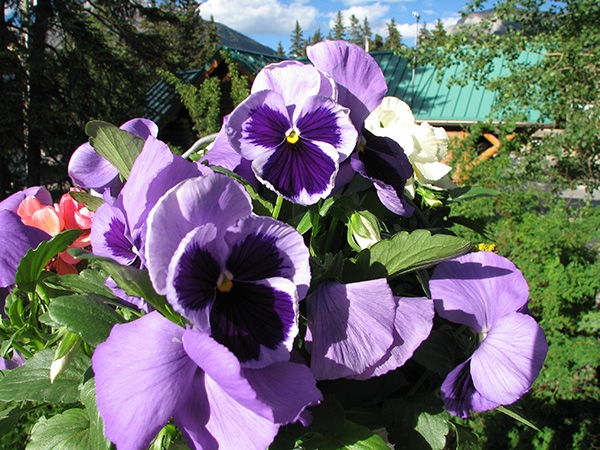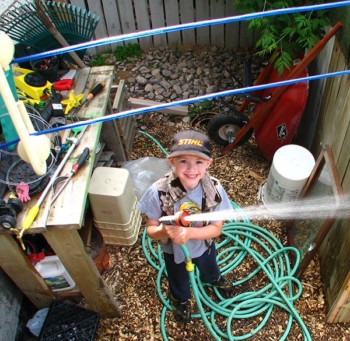Just as people speak of "spring cleaning" tasks performed to freshen up a home that has been shuttered up all winter, so lawns and the rest of your landscaping need some TLC at this time of year, to prepare your yard for the growing season. A spring yard cleanup checklist can be divided into five categories of related tasks, one of which truly does involve something of a cleansing: the removal of refuse (natural or otherwise) from your grass and planting beds.
The other types of tasks discussed below involve getting your yard ready for gardening:
• Preparing flower beds
• Planting
• Pest control
• Weed control
• Plant care
A thorough spring yard cleanup readies your lawn and landscaping for summer, but it can accomplish more than just that. In some cases, it will save you from headaches farther down the road.
Spring Yard Cleanup With Rake, Trash Bags, and Scissors
In this first category of spring yard cleanup tasks, you will be picking up after Old Man Winter and any other slovenly bad neighbors you may have to put up with. Roll up your sleeves and start removing:
• Litter and dog feces
• Dead grass, leaves, pinecones, etc. on lawns
• Dead leaves and stalks on perennials
Unfortunately, many neighborhoods contain at least a few thoughtless individuals who insist on being litterbugs. One of the first spring cleanup tasks to tackle is removing the litter they've deposited in the yard over the course of the winter, the sight of which tends to put a damper on even the most pristine April day.
Don some heavy work gloves for this task, as it may involve removing broken glass.
Another unpleasant task in spring yard cleanup is dog waste disposal. It's especially unpleasant when you have to clean up after someone else's dog. There's not much you can do to stop litter, but there is something you can do to help keep other people's dogs from defecating on your property: Begin researching dog repellents.
You don't want to be out there all summer long with a pooper-scooper, do you? And no, don't compost dog feces, for the same reason you shouldn't try to compost cat poop: Carnivore feces contain pathogens, the removal of which through the composting process is best left to experts.
With the less wholesome aspects of spring cleanup out of the way, let's move on to lawn care. If you raked leaves thoroughly in the fall, you've aided your chances of avoiding the fungal disease known as "snow mold." But, inevitably, there will still be some stray leaves to rake come March. That's all right because even without leaves you would want to break out the rake as part of your spring cleaning work on the lawn. Why? Because a deep raking will also help control thatch build-up.
While you're raking the lawn, you'll also want to remove pinecones or any other instances of "nature's refuse." Pinecones don't break down particularly easy in a compost bin unless they are first shredded. Some people use pinecones in craft projects, such as making kissing balls, but, for the rest of us, they're just a nuisance.

Spring cleanup in the perennial bed begins with removing any dead leaves and stalks from perennials and ornamental grasses that you didn't remove in fall.
Scissors often work better than pruners for this task (you can get into tight spaces easier with them). For more on spring cleanup in perennial beds, see below.
Spring cleaning outdoors can be tackled in a much more joyous state of mind if you dangle a carrot in front of your nose the whole time. By "carrot" we are talking here about the reward with which tidying up outside culminates: planting and transplanting. But first things first. Let's take a look at preparing beds, before getting to planting and prevention issues.
Preparing Planting Beds and Fertilizing
In established perennial beds that performed well the prior year, working in some additional compost around your plants to fertilize them is the best thing you can do (beyond the tasks already discussed). Also remove weed plants as you encounter them (plus old, dead growth you didn't remove in the fall) -- no sense in letting them get ahead of you.
While on the subject of compost, note that it's not just for planting beds. Most all of your plants (including the grass in your lawn and your trees and shrubs) will enjoy a feeding of compost in the spring (later in the year, too, for that matter). The great thing about using compost as a fertilizer is that you never have to worry about burning plants with it. Compost is nature's slow-release fertilizer.
If you must use chemical fertilizers, always be careful to follow the application directions, because chemical fertilizers will burn plants when used in excess. The one chemical fertilizer that really is convenient (at least in theory) is the "weed and feed" type that contains a preemergent herbicide to prevent crabgrass.
To open up brand new planting beds, you have a few options, including:
• Using a tiller to break new ground.
• Killing grass using a smothering method, to convert lawn space into a planting bed.
• Building raised beds.
In particularly rough areas, you may wish to consider soil solarization.
If you've just opened up a planting bed by breaking new ground, you can be sure that weeds will find it quickly. That's why, in some situations, it's smart to lay a landscape fabric over the ground and cover it with a layer of mulch (the mulch protects the landscape fabric from harmful UV rays). Many don't like landscape fabric in vegetable planting beds, where gardeners like to be able to reach down, scoop up a handful of soil, and admire its fertility up-close and personal; go with just a straight mulching here (straw is a favorite), if you feel the same way. But in a shrub planting bed, these weed barriers are a great ally in helping you achieve a low-maintenance yard.
Planting in Your Prepared Flower Beds
Early spring is a good time to install trees and shrubs and to plant perennial flower borders, as long as they're hardy perennials. For annuals and tender perennials, wait till the last frost date has passed for your region.
You can also start new lawns in spring or overseed a lawn that you already have.
However, if you will be applying a preemergent herbicide in spring to control crabgrass in an existing lawn, it may be better to overseed in the fall.
Prevention: Crabgrass, Garden Pests
Sometimes it's easier to fight weeds before they even emerge, rather than waiting till they rear their ugly heads. The use of landscape fabric and mulch was mentioned above in the context of garden beds, but you can't use either of those on a lawn. That's where preemergent herbicides such as corn gluten come into play, particularly for crabgrass control. Spring is the time to use a pre-emergent herbicide on crabgrass, and timing is of the essence. Crabgrass seed germinates when the soil temperature reaches 55 to 60 F. You need to apply the preemergent herbicide prior to this juncture. But who wants to keep sticking a thermometer in the ground to see if it's time yet, right? There's a more convenient method, used by the old-timers, and it involves keeping tabs on the flowering shrubs in your area. According to this method, just apply the preemergent herbicide sometime between the time the forsythias stop blooming and the lilacs begin blooming.
Garden pests pose another challenge that can best be addressed by taking preventive measures, in many cases. Many gardens need to be protected with rabbit-proof fences or deer fencing. In regions plagued by deer, it's a smart idea to plant deer-resistant plants where fencing isn't an option. An even greater number of gardeners are well advised to look into growing rabbit-proof flowers.
When Is the Best Time to Prune Shrubs?
There are different reasons to remove wood from shrubs. If we're talking about old, dead wood or wood recently damaged by winterkill, then the question is quite different in nature from when we're discussing healthy wood.
Yes, trees and shrubs can often profit from a bit of spring cleaning, too. Dead limbs and winterkill on branches should be pruned off. This is the easy part of pruning: Remember, you can't go wrong pruning off something that's already dead. And life and death are "color-coded" on trees and shrubs, just beneath their bark, with brown signaling death, green life. The key is determining where the brown ends and the green begins.
But when is the best time to prune shrubs, in terms of healthy wood? Here, the question is different, because you can go wrong with your timing. And while dead branches should always be removed, the necessity of pruning off live branches is often determined by one's eye for beauty on a small shrub (to give it a more aesthetically pleasing shape).
The question of the best time to prune flowering shrubs is the one that causes people more trepidation every spring since improper pruning will result in the loss of the blossoming displays to which we so look forward all winter long. To simplify, think of it this way:
Shrubs that bloom in spring have to have their buds already in place, on old wood (last year's growth), so that they're ready to kick into action when the warm weather comes; if you prune these branches off, you lose the flowers.
But shrubs that bloom later in the year don't need that head start, blooming instead on new wood (growth produced in the current season).
Group 1 above includes flowering shrubs such as:
• Forsythia
• Korean spice viburnum
• Lilacs
• Wait to prune such shrubs until after they have finished blooming.
Group 2 above includes flowering shrubs such as:
• Butterfly bush
• Rose of Sharon
• Lavender
• Bluebeard
• Beautyberry
You can go ahead and prune such shrubs in late winter or early spring, if you wish, without fear of losing blooms.
Plant Care in Spring: What About the Mulch Covering Perennials?
Regarding any deep layer of mulch, you may have had covering your perennials during the winter, it is a good idea to monitor the situation to determine when to pull it away so that the perennials can come through unhindered. An exact date cannot be provided for when to remove the mulch protecting your perennials: You have to play it by ear, and when exactly you remove such mulch will, obviously, vary according to where you live. But if you've applied a deep layer of mulch, it will eventually need to be scraped away from the ground immediately under which your perennials lie, as otherwise, it may smother the perennials. The best approach, once the ground is starting to thaw, is to begin checking, in late winter or early spring, to see whether your perennials are pushing up. If they are, remove the mulch when it's warm out but replace it when the cold returns (until the cold stops returning altogether).
Plant Care in Spring: Dividing Perennials
Finally, some perennials can profit at times from being divided. Most perennials can be divided in spring.


